Questions with Answers, Solution | Algebra | Chapter 3 | 8th Maths - Try these, Recap Exercise, Student Activities, Think and answer | 8th Maths : Chapter 3 : Algebra
Chapter: 8th Maths : Chapter 3 : Algebra
Try these, Recap Exercise, Student Activities, Think and answer
Recap Exercise
Answer the following questions :
1. Write the number of terms in the following expressions
(i) x + y + z − xyz
(ii) m2n2c
(iii) a2b2c − ab2c2 + a2bc2 + 3abc
(iv) 8x2 − 4xy + 7xy2
2. Identify the numerical co-efficient of each term in the following expressions.
(i) 2x2 − 5xy + 6 y2 + 7x −10 y + 9
(ii) x/3 + 2y/5 − xy + 7
(i) 2x2 − 5xy + 6y2 + 7x − 10y + 9
Answer:
Numerical co efficient in 2x2 is 2
Numerical co efficient in −5xy is −5
Numerical co efficient in 6y2 is 6
Numerical co efficient in 7x is 7
Numerical co efficient in −10y is − 10
Numerical co−efficient in 9 is 9
(ii) x/3 + 2y/5 − xy + 7
Answer:
Numerical co efficient in x/3 is 1/3
Numerical co efficient in 2y/5 is 2/5
Numerical co efficient in −xy is −1
Numerical co efficient in 7 is 7
3. Pick out the like terms from the following:
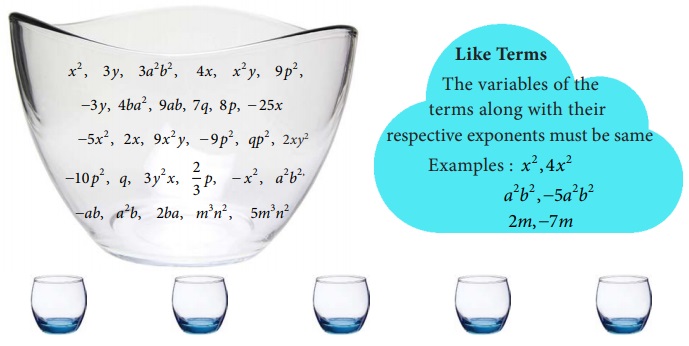
Solution:
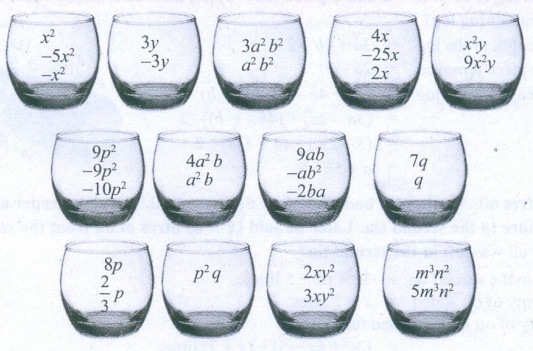
4. Add : 2x , 6 y, 9x − 2y
Solution:
2x + 6y + 9x − 2y = 2x + 9x + 6y − 2y = (2 + 9)x + (6 − 2)y = 11x + 4y
5. Simplify : (5x 3 y3 − 3x 2 y2 + xy + 7) + (2xy + x 3 y3 − 5 + 2x 2 y2 )
Solution:
(5x3y3 − 3x2y2 + xy + 7) + (2xy + x3y3 − 5 + 2x2y2)
= 5x3y3 + x3y3 – 3x2y2 + 2x2y2 + xy + 2xy + 7 − 5
= (5 + 1) x3y3 + (−3 + 2) x2y2 + (1 + 2) xy + 2
= 6 x3y3 − x2y2 + 3xy + 2
6. The sides of a triangle are 2x − 5y + 9, 3y + 6x − 7 and −4 x + y + 10 . Find the perimeter of the triangle .
Solution:
Perimeter of the triangle = Sum of three sides
= (2x − 5y + 9) + (3y + 6x −7) + (−4x + y + 10)
= 2x − 5y + 9 + 3y + 6x − 7 − 4x + y + 10
= 2x + 6x − 4x − 5y + 3y + y + 9 − 7 + 10
= (2 + 6 − 4)x + (−5 + 3 + l) y + (9 − 7 + 10)
= 4x –y + 12
∴ Perimeter of the triangle = 4x –y + 12 units.
7. Subtract −2mn from 6mn.
Solution:
6 mn − (−2 mn) = 6 mn + (+2 mn)
= (6 + 2) mn = 8 mn
8. Subtract 6a 2 − 5ab + 3b2 from 4a 2 − 3ab + b2 .
Solution:
(4a2 − 3ab + b2) − (6a2 − 5ab + 3b2)
= (4a2 − 6a2) + (− 3ab − (−5 ab)] + (b2 − 3b2)
= (4 − 6) a2 + [−3ab + (+5 ab)] + (1 − 3) b2
= [4 + (− 6)] a2 + (−3 + 5) ab + [1+ (−3)] b2
= −2a2 + 2ab − 2b2
9. The length of a log is 3a + 4b − 2 and a piece (2a − b) is removed from it. What is the length of the remaining log?
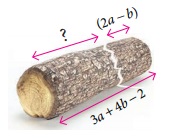
Solution:
Length of the log = 3a + 4b − 2
Length of the piece removed = 2a − b
Remaining length of the log = (3a + 4b −2) − (2a − b)
= (3a – 2a) + [4b − (− b)] − 2
= (3 − 2)a + (4 + 1)b − 2
= a + 5b – 2
10. A tin had x litres of oil. Another tin had (3x2 + 6x − 5) litres of oil.
The shopkeeper added (x+7) litres more to the second tin. Later, he sold (x2+6) litres of oil from the second tin. How much oil was left in the second tin?
Solution:
Quantity of oil in the second tin = 3x2 + 6x − 5 litres.
Quantity of oil added = x + 7 litres
∴ Total quantity of oil in the second tin
= (3x2 + 6x − 5) + (x + 7) litres
= 3x2 + (6x + x) + (−5 + 7) = 3x2 + (6 + 1 )x + 2
= 3x2 + 7x + 2 litres
Quantity of oil sold = x2 + 6 litres
∴ Quantity of oil left in the second tin
= (3x2 + 7x + 2) − (x2 + 6) = (3x2 − x2) + 7x + (2 − 6)
= (3 − 1) x2 + 7x + (−4) = 2x2 + 7x − 4
Quantity of oil left = 2x2 + 7x − 4 litres
Think
Every algebraic expression is a polynomial. Is this statement true? Why?
Solution:
No, This statement is not true. Because Polynomials contain only whole numbers as the powers of their variables. But an algebraic expression may contains fractions and negative powers on their variables.
Eg. 2y2 + 5y−1 − 3 is a an algebraic expression. But not a polynomial.
Try these
Find the product of
(i) 3ab2 , −2a2b3
(ii) 4xy, 5 y2 x,(−x2 )
(iii) 2m, −5n, −3p
Solution:
(i) (3ab2) × (−2a2b3) = (+) × (−) × (3 × 2) × (a × a2) × (b2 × b3) = − 6a3 b5
(ii) (4xy) × (5y2x) × (−x2) = (+) × (+) × (−) × (4 × 5 × 1) × (x × x × x2) × (y × y2)
= −20 x4y3
(iii) (2m) × (−5n) × (−3p) = (+) × (−) × (−) × (2 × 5 × 3) × m × n × p
= + 30 mnp = 30 mnp
Think
Why 3+(4x–7y) ≠ 12x−21y ?
Solution:
Addition and multiplication are different 3 + (4x − 7y) = 3 + 4x − 7y
We can add only like terms.
Try these
Multiply
(i) (5 x2 + 7x – 3) by –4x2
(ii) (10x – 7y + 5z) by 6xyz
(ii) (ab+3bc –5ca) by 3a2bc
(iv) (4m2 – 3m + 7) by –5m3
Solution:
(i) (5x2 + 7x − 3) by – 4x2

(5x2 + 7x − 3) × (– 4x2) = 5x2 (− 4x2) + 7x (− 4x2) − 3(− 4x2)
= − 20 x4 − 28x3 + 12x2
(ii) (10x −7y + 5z) by 6xyz

(10x −7y + 5z) × 6xyz = 6xyz (10x − 7y + 5z) [∵ Multiplication is commutative]
= 6xyz(10x) + 6xyz(−7y) + 6xyz(5z)
= (6 × 10) (x × x × y × z) + (6 × −7) + (x × y × y × z ) + (6 × 5)(x × y × z × z)
= 60x2yz + (−42xy2z) + 30xyz2
= 60x2yz − 42xy2z + 30xyz2
(iii) (ab + 3bc − 5ca) by 3a2 bc
(ab + 3bc − 5ca) × (3a2bc) = ab(3a2bc) + 3bc (3a2bc) − 5ca (3a2bc)
= 3a2b2c + 9a2b2c2 − 15a3bc2
(iv) (4m2 − 3m + 7) by − 5m3
(4m2 − 3m + 7) × (− 5m3) = 4m2 (− 5m3) − (3m) (− 5m3) + 7(− 5m3)
= − 20m5 + 15m4 − 35m3
Try these
Multiply
(i) (a − 5) and (a + 4)
(ii) (a + b) and (a − b)
(iii) (m4 + n4 ) and (m − n)
(iv) (2x + 3)(x + 4)
(v) (3x + 7)( x −5)
(vi) (x − 2)(6x − 3)
Solution:
(i) (a − 5) and (a + 4)
(a − 5) (a + 4) = a(a + 4) − 5(a + 4)
= (a × a) + (a × 4) + (−5 × a) + (−5 × 4)
= a2 + 4a − 5a − 20 = a2 − a − 20
(ii) (a + b) and (a − b)
(a + b) (a − b) = a(a − b) + b(a − b)
= (a × a) + (a × −b) + (b × a ) + b(− b)
= a2 − ab + ab − b2 = a2 − b2
(iii) (m4 + n4) and (m − n)
(m4 + n4) (m − n) = m4 (m − n) + n4 (m − n)
= (m4 × m) + (m4 × (− n)) + (n4 × m) + (n4 × (−n))
= m5 − m4 n + mn4 – n5
(iv) (2x + 3) (x + 4)
(2x + 3) (x + 4) = 2x(x + 4) + 3(x + 4)
= (2x2 × x) + (2x × 4) + (3 × x) + (3 × 4)
= 2x2 + 8x + 3x + 12 = 2x2 + 11x + 12
(v) (3x + 7) (x − 5)
(3x + 7) (x − 5) = x(3x + 7) − 5(3x + 7)
= (x × 3x) + (x × 7) + (−5 × 3x) + (−5 × 7)
= 3x2 + 7x − 15x − 35
= 3x2 − 8x – 35
(vi) (x − 2) (6x − 3)
(x − 2) (6x − 3) = x(6x − 3) − 2(6x − 3)
= (x × 6x) + (x × (−3) − (2 × 6x) − (2 × 3)
= 6x2 − 3x − 12x + 6
= 6x2 − 15x + 6
Think
(i) In 3x2 (x4–7x3+2), what is the highest power in the expression?
Solution:
3x2 (x4 − 7x3 + 2) = (3x2) (x4) + 3x2 (− 7x3) + (3x2)2
= 3x2 − 21x5 + 6x2
Highest power is 6 in x6.
(ii) Is –5y2 +2y–6 = –(5y2 +2y–6)? If not, correct the mistake.
Solution:
No, – 5y2 + 2y – 6 = − (5y2 − 2y + 6 )
Think
Are the following correct?
(i) x3/x8 = x8-3 = x5
(ii) 10m4 / 10m4 = 0
(iii) When a monomial is divided by itself, we will get 1?
Solution:
(i) x3 / x8 = x8 – 3 = x5
x3 / x8 = x3 – 8 = x−5 (or) x3 / x8 = 1 / x8 – 3 = 1 / x5
∴ The given answer is wrong.
(ii) 10m4 / 10m4 = 0
10m4 / 10m4 = [10/10] m4−4 = 1 m0 = 1 [ ∵ m0 = 1]
∴ The given answer is not correct
(iii) When a monomial is divided by itself, we will get 1?
When a monomial is divided by itself, we will get 1.
Eg. x/x = x1 – 1 = x0 = 1
∴ The given statement is correct
Try these
Divide
(i) 12x 3y2 by x2y (ii) −20a5b2 by 2a3b7 (iii) 28a4 c2 by 21ca2
(iv) (3 x 2 y)3 √6x2y3 (v) 64m4 (n2)3 ÷ 4m2n2 (vi) (8 x 2 y 2 )3 ÷ (8x 2 y2 )2
(vii) 81 p2q4 ÷ √[81p2q4 ]
(vii) ( 4x2 y3 )0 ÷ [( x3)2]/x6
Solution:

Solution:
(i) 12x3y2 / x2y = 12x3−2 y2−1 = 12x1y1 = 12 xy
(ii) −20a5b2 / 2a3b7 = −20a5 − 3 / 2b7 − 2 = −10a2 / b5
(iii) 28 a4c2 / 21ca2 = [28 / 21] a4 – 2 c2 – 1 = 4/3 a2c1 = 4/3 a2c
(iv) (3x2y)3 / 6x2y3 = 27 x6y3 / 6 x2y3 = [9/2] x6–2 = 9/2 x4
(v) 64m4(n2)3 / 4m2n2 = 64m4n6 / 4m2n2 = 16 m4−2 n6−2 = 16 m2n4
(vi) (8x2y2)3 / (8x2y2)2 = 512 x6y6 / 64 x4y4
= 8x6−4 y6−4
= 8x2y2
(vii) 81p2q4 / √81p2q4 = 81p2q4 / 9pq2 = 9 p2−1q4–2 = 9 pq2
(viii) (4x2y3)0 / [ (x3)2 / x6 ] = 1 / [ x6 / x6 ] = 1 / 1 = 1
Think
Are the following divisions correct?

Solution:
(i) [4y + 3] / 4 = y + 3

[4y + 3] / 4 = [4y / 4] + [3 / 4] = y + [3/4] is the correct answer.
∴ The given answer is not correct.
(ii) [5m2 + 9] / 9 = 5m2

[5m2 + 9] / 9 = [5m2 / 9] + [9 / 9] = [ 5/9 m2 ] + 1 is the correct answer
∴ The given answer is not correct.
(iii) [2x2 + 8] / 4 = 2x2 + 2 If not, correct it.

[2x2 + 8] / 4 = [(2x2) / 4 ] + [ 8 / 4 ] = (1/2) x2 + 2 is the correct answer
∴ The given answer is not correct.
Try these
(i) (16 y5 − 8y2 ) ÷ 4 y
(ii) ( p5 q2 + 24 p3 q −128q3 ) ÷ 6q
(iii) (4m2n + 9n2m + 3mn) ÷ 4mn
Solution:
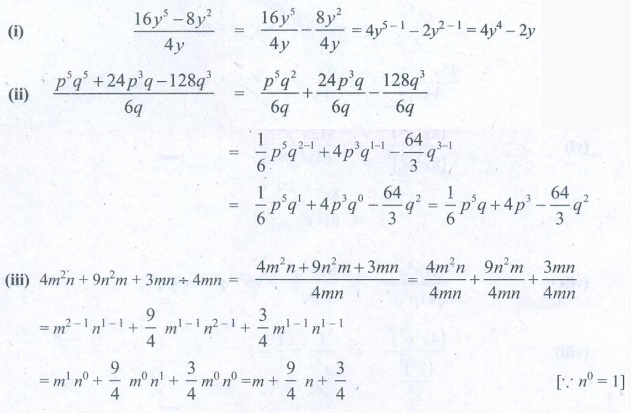
(i) (16y5 − 8y2) ÷ 4y
(16y5 − 8y2) / 4y = [16y5 / 4y ]− [ 8y2 / 4y ] = 4y5 – 1 − 2y2 – 1 = 4y4 – 2y
(ii) ( p5q2 + 24p3q − 128 q3 ) ÷ 6q
( p5q2 + 24p3q − 128 q3 ) / 6q = [ p5q2 / 6q ] + [ 24p3q / 6q ] – [ 128q3 / 6q ]
= (1/6) p5q2 – 1 + 4p3q1 – 1 – (64/3)q3 – 1
= (1/6)p5q1 + 4p3q0 – (64/3)q2 = (1/6)p5q + 4p3 – (64/3)q2
(iii) ( 4m2n + 9n2m + 3mn ) ÷ 4mn
[ 4m2n + 9n2 m + 3mn ] / 4mn = [ 4m2n / 4mn ] + [ 9n2m / 4mn ] + [ 3mn / 4mn ]
= m2−1n1−1 + (9/4) m1−1n2−1 + (3/4)m1−1n1−1
= m1n0 + (9/4)m0 n1 + (3/4)m0n0 = m + (9/4)n + 3/4. [ ∵ n0 =1]
Try these
Expand the following
(i) ( p + 2)2 =
(ii) (3 − a)2 =
(iii) (62 − x2 ) =
(iv) (a + b)2 − (a − b)2 =
= a2 + 2ab + b2 − a2 + 2ab − b2
= (1 − 1) a2 + (2 + 2) ab + (+1 −1) b2 = 4ab
(v) (a + b)2 = (a + b) ×
(vi) (m + n)(m − n) = m2 − n2
(vii) (m + 7)2 = m2 + 14m + 49
(xiii) (k2 - 49) = (k+ 7 )(k - 7 )
(ix) m2 − 6m + 9 =
(x) (m − 10)(m + 5) =
Think
Which is corrcet? (3a)2 is equal to
(i) 3a2 (ii) 32a (iii) 6a2 (iv) 9a2
[Answer: (iv) 9a2]
Solution: (3a)2 = 32a2 = 9a2
Try these
Expand using appropriate identities.
(i) (3 p + 2q)2
(ii) (105)2
(iii) (2x − 5d)2
(iv) (98)2
(v) ( y − 5)( y + 5)
(vi) (3x)2 − 52
(vii) (2m + n)(2m + p)
(viii) 203 ×197
(ix) Find the area of the square whose side is (x − 2) units.
(x) Find the area of the rectangle whose length and breadth are ( y + 4) units and ( y − 3) units.
Solution:
1) (3p + 2q)2
Comparing (3p + 2q)2 with (a + b)2, we get a = 3p and b = 2q.
(a + b)2 = a2 + 2ab + b2
(3p + 2q)2 = (3p)2 + 2(3p) (2q) + (2q2) = 9p2 + 12pq + 4q2
2) (105)2 = (100+ 5)2
Comparing (100 + 5)2 with (a + b)2, we get a = 100 and b = 5.
(a + b)2 = a2 + 2ab + b2
(100 + 5)2 = (100)2 + 2 (100) (5) + 52 = 10000+ 1000 + 25
1052 = 11,025
3. (2x − 5d)2
Comparing with (a – b)2, we get a = 2x b = 5d.
(a − b)2 = a2 − 2ab + b2
(2x − 5d)2 = (2x)2 − 2 (2x) (5d) + (5d)2
= 22x2 − 20xd + 52d2 = 4x2 − 20xd + 25d2
4. (98)2 = (100 − 2)2
Comparing (100− 2)2 with (a − b)2 we get
a = 100, b = 2
(a − b)2 = a2 − 2ab + b2
(100 − 2)2 = 1002 − 2 (100) (2) + 22
= 10000 − 400 + 4 = 9600 + 4 = 9604
5. (y − 5) (y + 5)
Comparing (y − 5) (y + 5) with (a − b) (a + b) we get
a = y ; b = 5
(a − b) (a + b) = a2 − b2
(y − 5)(y + 5) = y2 − 52 = y2 – 25
6. (3x)2 − 52
Comparing (3x)2 − 52 with a2 − b2 we have
a = 3x ; b = 5
(a2 − b2) = (a + b) (a − b)
(3x)2 − 52 = (3x + 5) (3x − 5) = 3x (3x − 5) + 5 (3x − 5)
= (3x) (3x) − (3x) (5) + 5 (3x) − 5 (5)
= 9x2 − 15x + 15x − 25 = 9x2 – 25
7. (2m + n) (2m + p)
Comparing (2m + n) (2m + p) with (x + a) (x + b) we have
x = 2n ; a = n ; b = p
(x − a)(x + b) = x2 + (a + b) x + ab
(2m + n) (2m + p) = (2m2) + (n + p)(2m) + (n) (p)
= 22m2 + n (2m) + p (2m) + np
= 4m2 + 2mn + 2mp + np
8. 203 × 197 = (200 + 3) (200 − 3)
Comparing (a + b) (a − b) we have
a = 200, b = 3
(a + b) (a − b) = a2 − b2
(200 + 3) (200 − 3) = 2002 − 32
203 × 197 = 40000 − 9
203 × 197 = 39991
9. Side of a square = x − 2
∴ Area = Side × Side
= (x − 2) (x − 2) = x (x − 2) −2 (x − 2)
= x(x) + (x) (−2) + (−2)(x) + (−2) (−2)
= x2 − 2x − 2x + 4
= x2 − 4x + 4 units square
10. Length of the rectangle = y + 4
breadth of the rectangle = y − 3
Area of the rectangle = length × breadth
= (y + 4)(y − 3) = y2 + (4 + (−3)) y + (4) (−3)
= y2 + y – 12
Activity
You can visualize the geometrical proof of (a+b)3 with the help of your teacher.
Try these
Expand : (i) ( x + 5)3 (ii) ( y − 2)3 (iii) (x + 1)(x + 4)(x + 6)
Solution:
(i) Comparing (x + 5)3 with (a + b)3, we have a = x and b = 4.
(a + b)3 = a3 + 3a2 b + 3ab2 + b3
(x + 5)3 = x3 + 3x2 (5) + 3 (x) (5)2 + 53
. = x3 + 15x2 + 75x + 125
(ii) Comparing (y − 2)3 with (a − b)3 we have a = y b = z
(a − b)3 = a3 − 3a2 b + 3ab2 − b3
(y − 2)2 = y3 – 3y2(2) + 3y(2)2 + 23
= y3 − 6y2 + 12y + 8
(iii) Comparing (x + 1) (x + 4) (x + 6) with (x + a) (x + b) (x + c) we have
a = 1 b = 4 and c = 6
(x + a) (x + b) (x + c) = x3 + (a + b + c) x2 + (ab + bc + ca) x + abc
= x3 + (1 + 4 + 6) x2 + ((1) (4) + (4) (6) + (6) (l))x + (1) (4) (6)
= x3 + 11x2 + (4 + 24 + 6) x +24
= x3 + 11x2 + 34x + 24
Try these
Find the factors
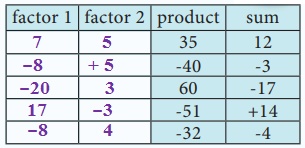
Think
x2–4(x–2) = (x2–4)(x–2)
Is this correct? If not correct it.
Solution:
Not correct
(3a)2 = 32a2 − 9a2
x2 − 4(x − 2) = x2 – 4x + 8
Try these
Factorise the following :
1) 3y + 6
2) 10x 2 +15y2
3) 7m(m − 5) + 1(5 − m)
4) 64 − x2
5) x2–3x+2
6) y2–4y–32
7) p2+2p–15
8) m2+14m+48
9) x2–x–90
10) 9x2–6x–8
Solution:
1. 3y + 6
3y + 6 = 3 × y + 2 × 3
Taking out the common factor 3 from each term we get 3 (y + 2)
∴ 3y + 6 = 3(y + 2)
2. 10x2 + 15y2
10x2 + 15y2 = (2 × 5 × x × x) + (3 × 5 × y × y)
Taking out the common factor 5 we have
10x2 + 15y2 = 5(2x2 + 3y2)
3. 7m (m − 5) + (15 – m)
7m (m − 5) + (15 – m) = 7 m (m − 5) + (−1 )(−5 + m)
= 7m (m − 5) − 1(m − 5)
Taking out the common binomial factor (m − 5) = (m − 5) (7 m − 1)
4. 64 − x2
64 − x2 = 82 − x2
This is of the form a2 − b2
Comparing with a2 − b2 we have a = 8, b = x
a2− b2 = (a + b) (a − b)
64 − x2 = (8 + x) (8 − x)
5. x2 – 3x + 2
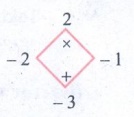
x2 – 3x + 2 = x2 − 2x − x + 2
= x (x − 2) − (x − 2)
= (x − 2) (x − l)
6. y2 – 4y – 32
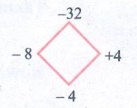
y2 – 4y – 32 = y2 – 8y + 4y − 32
= y(y − 8) + 4(y − 8)
= (y − 8) (y + 4)
7. p2 + 2p – 15
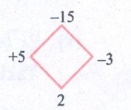
p2 + 2p – 15 = p2 + 5p −3p − 15
= p(p + 5) −3 (p + 5)
= (p + 5) (p − 3)
8. m2 + 14 m + 48
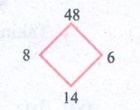
m2 + 14 m + 48 = m2 + 8 m + 6 m + 48
= m (m + 8) + 6 (m + 8)
= (m + 6) (m + 8)
9. x2 − x – 90
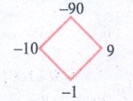
x2 − x – 90 = x2 − 10x + 9x − 90
= x (x − 10) + 9 (x − 10)
= (x + 9) (x − 10)
10. 9x2 − 6x – 8
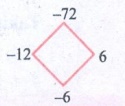
9x2 − 6x – 8 = 9x2 − 12x + 6x − 8
= 3x (3x − 4) + 2(3x − 4)
= (3x + 2) (3x − 4)
Try these
Identify which among the following are linear equations.
(i) 2 + x = 19
(ii) 7x2 – 5 = 3
(iii) 4p3 = 12
(iv) 6m+2
(v) n=10
(vi) 7k – 12= 0
(vii) 6x/8 + y = 1
(viii) 5 + y = 3x
(ix) 10p+2q=3
(x) x2–2x–4
Think
(i) Is t(t – 5)=10 a linear e quation? Why?
Solution:
t(t − 5) = 10
= (t × t) – (5 × t) = 10
= t2 − 5t = 10
This is not a linear equation as the highest degree of the variable ‘t’ is 2
(ii) Is x2 =2x , a linear equation? Why?
Solution:
x2 = 2x
= x2 − 2x = 0
This is not a linear equations as the highest degree of the variable ‘x’ is 2
Try these
Convert the following statements into linear equations:
• On subtracting 8 from the product of 5 and a number, I get 32.
Solution:
Convert to linear equations:
Given that on subtracting 8 from product of 5 and a, we get 32
∴ 5 × x − 8 = 32
∴ 5x − 8 = 32
• The sum of three consecutive integers is 78.
Solution:
Sum of 3 consecutive integers is 78
Let 1st integer be ‘x’
∴ x + (x + 1) + (x + 2) = 78
∴ x + x + l + x + 2 = 78
3x + 3 = 78
• Peter had a Two hundred rupee note. After buying 7 copies of a book he was left with ₹60.
Solution:
Let cost of one book be ‘x’
∴ Given that 200 −7 × x = 60
∴ 200 − 7x = 60
• The base angles of an isosceles triangle are equal and the vertex angle measures 80°.
Solution:
Let base angles each be equal to x & vertex bottom angle is 80°. Applying triangle property, sum of all angles is 180°
∴ x + x + 80 = 180°
∴ 2x + 80 = 180
• In a triangle ABC, ∠A is 10o more than ∠B. Also ∠C is three times ∠A. Express the equation in terms of angle B.
Solution:
Let ∠B = b
Given ∠A = 10° + ∠B = 10 + b
Also given that ∠C = 3 × ∠A = 3 × (10 + b) = 30 + 3b
Sum of the angles = 180°
∠A + ∠B + ∠C = 180°
10 + b + b + 30 + 3b = 180°
∴ 5b + 40 = 180°
Think
Can you get more than one solution for a linear equation?
Solution:
Yes, we can get. Consider the below line or equation
x + y = 5
here, when x = 1, y = 4
when x = 2, y = 3
x = 3, y = 2
x = 4, y = 1
Hence, we get multiple solutions for the same linear equation.
Try these
1. Solve for ‘x’ and ‘y’
(i) 2x = 10
(ii) 3 + x = 5
(iii) x – 6 = 10
(iv) 3x + 5 = 2
(v) 2x/7 = 3
(vi) –2 = 4m – 6
(vii) 4(3x – 1) = 80
(viii) 3x – 8 = 7 – 2x
(ix) 7 – y = 3(5 – y)
(x) 4(1 – 2y)–2(3 – y) = 0
Solution:
(i) 2x = 10
⇒ x = 10 / 2 = 5
(ii) 3 + x = 5
⇒ 3 + x = 5
x = 5 – 3 = 2
(iii) x − 6 = 10
⇒ x − 6 = 10
x = 10 + 6 = 16
(iv) 3x + 5 = 2
⇒ 3x + 5 = 2
3x = 2 – 5 = − 3
x = −3/3 = −1
(v) 2x/7 = 3
⇒ 2x = 3 × 7 = 21
x = 21/2
(vi) − 2x = 4m − 6
⇒ − 2x = 4m − 6
−2 + 6 = 4m
4 = 4m
m = 4 / 4 = 1
(vii) 4(3x − 1) = 80
⇒ 4(3x − l) = 80
12x − 4 = 80
12x = 80 + 4 = 84
x = 84 / 12 = 7
(viii) 3x − 8 = 7 − 2x
⇒ 3x − 8 = 7 − 2x
3x + 2x = 7 + 8 = 15
5x = 15
x = 15/5 = 3
(ix) 7 − y = 2(5 − y)
⇒ 7 − y = 3(5 − y)
7 − y = 15 − 3y
3y − y = 15 − 7
2y = 8
y = 8 / 2 = 4
(x) 4(l − 2y) − 2(3 −y) = 0
⇒ 4(1− 2y) – 2(3 − y) = 0
4 − 8y − 6 – 2y = 0
−2 − 6y = 0
6y = − 2
y = − 2 / 6 = −1 / 3
Think
1. “An equation is multiplied or divided by a non zero number on either side.” Will there be any change in the solution?
Solution:
Not be any change in the solution
2. “An equation is multiplied or divided by two different numbers on either side”. What will happen to the equation?
Solution:
When an equation is multiplied or divided by 2 different numbers on either side, there will be a change in the equation & accordingly, solution will also change.
Think
Suppose we take the second piece to be x and the first piece to be (200 − x), how will the steps vary? Will the answer be different?
Solution:
Let 2nd piece be ‘x’ & 1st piece is 200 − x
Given that 1st piece is 40 cm smaller than hence the other piece
∴ 200 − x = 2 × x − 40
200 − x = 2x – 40

∴ 200 + 40 = 2x + x
240 = 3x
∴ x = 240 / 3 = 80
∴ 1st piece = 200 – x = 200 – 80 = 120 cm
2nd piece = x = 80 cm
The answer will not change
Think
If instead of (4,3), we write (3,4) and try to mark it, will it represent ‘M’ again?
Solution:
Let 3, 4 be M, when we mark, we find that it is a different point and not ‘M’
Try these
1. Complete the table given below.
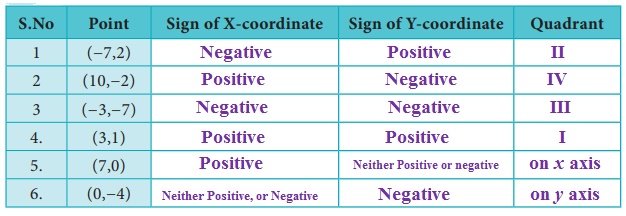
2. Write the coordinates of the points marked in the following figure
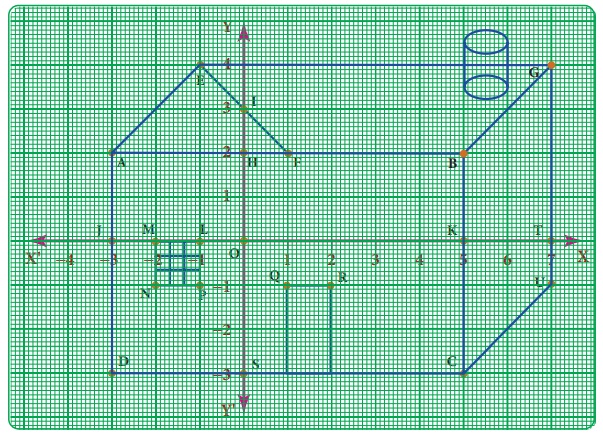
Solution:
A- (−3, 2) B - (5, 2) C- (5, −3) D - (−3, 3) E - (−l, 4)
F- (l, 2) G - (7, 4) H - (0, 2) I - (0, 3) J - (−3, 0)
K-(5, 0) L - (−l, 0) M - (−2, 0) N- (−2, −1) O - (0, 0)
P - (−1, −1) Q - (1, −1) R - (2, −l) S - (0, −3) T- (7, 0)
U - (7, −2)
Think
Which of the points (5, −10) (0, 5) (5, 20) lie on the straight line X = 5?
Solution:
All points on the line X = 5 will have X−coordinate as 5. Therefore, any point with X − coordinate as 5 will lie on X = 5 line. Hence the points (5, − 10) & (5,20) will lie on X = 5
Try these
Identify and correct the errors

Solution:

Note
Polynomial
A polynomial is an expression containing two or more algebraic terms. In a polynomial all variables are raised to only whole number powers.
a2 + 2ab + b2
4x2 + 3x – 7
A polynomial cannot contain :
1) Division by a variable. Eg. 4x2 – (5/1+x) is not a polynomial.
2) Negative exponents. Eg. 7x–2 + 5x – 6 is not a polynomial.
3) Fractional exponents. Eg. 3x3 + 4x1/2 + 5 is not a polynomial.
Monomial
An expression which contains only one term is called a monomial. Examples:
4x, 3x2 y, −2 y2 .
Binomial
An expression which contains only two terms is called a binomial.
Examples: 2x + 3, 5y2 + 9 y, a2b2 + 2b
Trinomial
An expression which contains only three terms is called a trinomial.
Examples : 2a2b −8ab + b2 , m2 −n 2 + 3
Note
Product of two terms is represented by the symbols ( ), dot (.) or × .
For example,
multiplying 4x2 and xy can be written in any one of the following ways.

Note
Distributive law
If a is a constant, x and y are variables then 
a(x + y) = ax + ay
For example, 5(x + y) = 5x + 5 y
Note
x =1 is the only solution for 7x + 3=10 whereas any value of x satisfies (x+2)2 = x2 + 4x + 4. So 7 x + 3=10 is an equation (x+2)2 = x2 + 4x + 4 is an identity. An identity is an equation but vice versa is not true.
Note
A number which is divisible by 1 and itself (or) A number which has only 2 factors are called prime numbers. Example: 2, 3, 5, 7, 11, ...
A number which has more than 2 factors are called composite numbers.Example: 4, 6, 8, 9, 10, 12, ...
Note
8a 3 = 2 × 2 × 2 × a3
= 23 a3 = (2a)3
Note
Perfect cube numbers
A number which can be written in the form of x × x × x is called perfect cube number
Examples
8=2×2×2=23
27=3×3×3=33
125=5×5×5=53
Here 8, 27, 125 are some of perfect cube numbers
Note
While rearranging the given linear equation, group the like terms on one side of the equality sign, and then do the basic arithmetic operations according to the signs that occur in the expression.
Note
x =0 represents the Y axis
y =0 represents the X axis
Note
The orientation of the graph will be different according to the scale chosen.